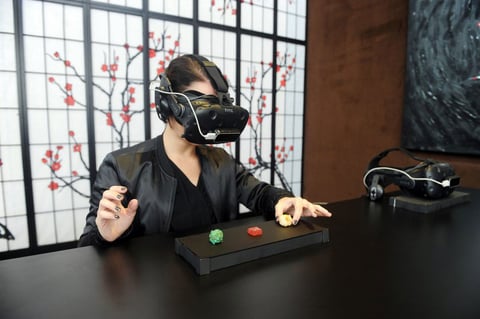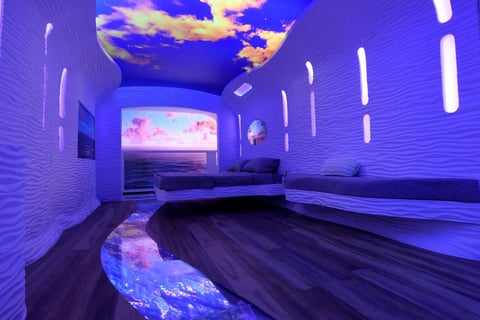At the reveal event for Royal Caribbean Cruises Ltd.’s new technology initiative, Excalibur, Travel Agent got a chance to preview a Sky Suite onboard the new Celebrity Edge, as well as a number of new, cutting-edge cruise concepts. Royal Caribbean Cruises Ltd. is the parent company of Celebrity Cruises, as well as Royal Caribbean International and Azamara Club Cruises.
Preview: The Sky Suite Onboard the Celebrity Edge
As part of the event, which took place in a greenhouse in the Brooklyn Naval Yard, Royal Caribbean built a replica of a Sky Suite as it will appear onboard the Celebrity Edge when the new ship sets sail for Celebrity Cruises in 2018.
The Sky Suite, which will serve as the Celebrity Edge’s entry-level suite, will incorporate a number of the stateroom automation features that are part of the Excalibur initiative. An in-room control panel allows guests to change the suite’s lighting, temperature and shades. Guests can also control these features from their smart device, either inside the stateroom or anywhere on the ship if, for example, they wanted to get their stateroom to the perfect temperature before returning. Guests can also unlock the suite door using a unique digital key Celebrity stores on their smart device although, conveniently, they won’t need to take the device out of their pocket to do so – simply having the device on their person is enough to unlock the door, as a Celebrity Cruises representative demonstrated.
When designing the automation Celebrity took pains to keep things simple. Lighting levels, temperatures and shade adjustments are grouped into “themes and moods” based on common guest activities within the suite. For example, a guest can select a “movie mood” to draw the shades and turn down the lights to watch a movie on the suite’s TV without distractions. (As another part of the Excalibur initiative, guests will be able to stream their content to the TV, either content stored locally on their device or from popular streaming services.) Afterward, an “evening view” mode opens the drapes but keeps the lighting dim to highlight the sunset.
The stateroom also incorporates voice controls. A Celebrity Cruises representative was able to turn out all the lights in the room by saying “Computer, good night.” Saying “Computer, good morning” turned several of them back on.
While only the Sky Suite was showcased during the event, a Celebrity Cruises representative told Travel Agent that the stateroom automation technology would be present in all of the new ship’s staterooms and suites. After the Celebrity Edge launches, the cruise line will continue monitoring guests’ responses to the new features in order to explore the possibility of retrofitting some of them into the rest of the fleet.

Photo by Diane Bondareff/ Invision for Royal Caribbean Cruises Ltd./AP Images
Virtual Reality Dining
While the Celebrity Edge is set to launch December 16, 2018, Royal Caribbean also showcased a number of more “far-out” technology concepts that could be making their way to a cruise ship at some point in the future. One of these was a virtual reality (VR) dining experience.
As part of the experience Travel Agent and other media were sat at a series of long tables. At each seat was a VR headset and headphones, as well as a small, black plate. After putting on the headsets (and cleaning our hands with a hot towel), we were transported into the illusion of a traditional Japanese-style tatami room, with our hands represented by virtual avatars that mapped to our real-life hand movements. Royal Caribbean representatives then placed a series of bites on the black plate in front of us, which were represented by colored balls of fire in the VR simulation. As we consumed each “course” using our real and digital hands, the scene changed, with the walls dramatically exploding to reveal a traditional Japanese garden in spring, followed by a winter and night scene.
The Japanese scene was well-rendered and immersive, but there were a few glitches that point to this technology still being in its early days. It was difficult to get the digital hands to “grab” the colored balls representing the food, although the digital hands seemed to follow our real-life hand movements well in other respects. In two out of the three courses we wound up eating the food in real life, and then going back to grab the virtual food, which made it disappear. It was also impossible to see our neighbors in the VR simulation, which limited it as a social experience – and meant frequent reminders to mind our elbows.
“VR dining is still an early concept,” Jay Schneider, Royal Caribbean Cruises Ltd.’s SVP of digital experience, told Travel Agent in a follow-up email. “We continue to talk about how we might put it on a ship; however, we still need to find the right concept that we can operationalize and need to see how folks respond to it. But it is a great example of how we are innovating across every aspect of our business.”

// Photo by Diane Bondareff/ Invision for Royal Caribbean Cruises Ltd./AP Images
The Stateroom of the Future
The event closed with a look inside the “cruise stateroom of the future.” We won’t be seeing this stateroom on a cruise ship anytime soon; instead, Royal Caribbean representatives likened it to a concept car.
Building on the “digital veranda” concept introduced on Quantum of the Seas, the stateroom incorporated a number of screens to create the illusion of being in an outdoor space. A “balcony” ended in a screen showcasing a sea and sky view, with a floor screen showing the waves below. A wavy floor screen throughout the rest of the stateroom also looked down onto the ocean, while side screens in each of the stateroom’s walls looked outward. Finally, a moon roof in the stateroom’s ceiling could draw back to expose another large screen showing the sky. Lightboxes recessed into the walls put out ambient light in the colors of the scenery on the screens, which added to the sense of being outdoors.
The screens could be changed in a number of ways, either displaying a view of the sea or port destination outside or, if the view outside was less than scenic, a view of a fictional outdoor scene. The representative running the demonstration even generated a virtual storm with wind and rain. The view could also act as an alarm clock, generating a virtual sunrise at a wake-up time set by the guest.
While it won’t involve VR Dining or the “stateroom of the future” concept, Royal Caribbean Cruises Ltd.’s Excalibur initiative will be rolling out a number of new technology enhancements across the Royal Caribbean, Celebrity and Azamara fleets in the coming years. The full rollout is expected to be in place by the end of 2019.
Related Stories
Strength in Europe Bolsters NCLH Earnings, Despite Weather Disruptions
Despite Hit From Hurricanes, Royal Caribbean Posts Record Q3 Earnings
Venice to Restrict Large Cruise Ships From Historic Center
St. Croix Set to Welcome First Cruise Ship Since Maria on November 11